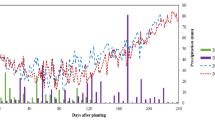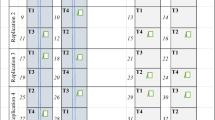Summary
In rainfed rice, the nitrogen status of soil and plant is closely related to the moisture regime in the soil. The lower the soil moisture content, the lower the nitrogen use efficiency in the plants.
In this study, the yield and growth responses of four rice cultivars to seven irrigation and three nitrogen levels were evaluated using the line source sprinkler system. Visual observations on the degree of drought reaction and measurement of leaf water potential (LWP) were also made.
The effect of drought was least on the traditional variety Kinandang Patong and most on the modern variety IR 20. Increasing nitrogen levels from 0 (no nitrogen fertilizer) to 60 and 120 Kg N/ha increased the degree of water stress. This also resulted in decreased LWP especially when the total water applied was minimal. At all levels of nitrogen, Kinandang Patong had significantly higher LWP than IR 20. There was a curvilinear decrease in the number of days to heading and a linear increase in plant height and dry matter production with increase in total water applied.
The yield-water-fertilizer relationships of the four cultivars revealed different production surfaces. The early-maturing IR 52 rice gave the highest grain yield at 120 kg N/ha and with maximum water application of 850 mm. Without nitrogen fertilizer application, Kinandang Patong gave the highest predicted yield with 550 mm of water applied. At 120 kg N/ha and 550 mm of water, IR 36 was superior in yield to other rices tested.
Results suggest that in areas of uncertain moisture supply, nitrogen application rate should be reduced from that normally used for irrigated rice.
Similar content being viewed by others
References
Barber SA (1962) A diffusion and mass flow concept of soil nutrient availability. Soil Sci 93:39
Bartholomew FP (1971) The limitation of natural process in supplying nitrogen for modern crop production. Proc Int Symp Soil Fert Eval 1:619–630
Bauder JW, Hanks RJ, James DW (1975) Crop production function determinations as influenced by irrigation and nitrogen fertilization using a continuous variable design. Soil Sci Soc Am J 39:1187
Box GEP, Hunter JS (1958) Experimental designs for exploring response surfaces. In: Chew V (ed) Experimental designs in industry. John Wiley and Sons Inc, pp 138–190
Brown DA (1953) Cation exchange in soils through the moisture range, saturation to the wilting percentage. Soil Sci Soc Am Proc 17:92
Chandra Mohan J (1965) Water requirement of rice crop in Madras. Madras Agric J 52(5):230
Choudhury PN, Kumar V (1980) The sensitivity of growth and yield of dwarf wheat to water stress at three growth stages. Irrig Sci 1:223
Danielson RE, Russell MB (1957) Ion absorption by corn roots as influenced by moisture and aeration. Soil Sci Soc Am Proc 21:3
De Datta SK, Faye FG, Mallick RN (1974) Soil-water relations in upland rice. In: Bornemisza E, Alvarado A (eds) Soil management in tropical America. Proc of a seminar held at CIAT, Cali Colombia, February 10–14,1974
Fox RL (1973) Agronomic investigations using continuous function experimental designs — nitrogen fertilization of sweet corn. Agron J 65:454
Fried M, Shapiro RE (1961) Soil plant relationship in ion uptake. Annu Rev Plant Physiol 12:91
Hanks RJ, Keller J, Rasmussen VP, Wilson GD (1976) Line source sprinkler for continuous variable irrigation — crop production studies. Soil Sci Soc Am J 40:426
Hanks RJ, Sisson DV, Hurst RL, Hubbard KG (1980) Statistical analysis of results from irrigation experiments using the line source sprinkler system. Soil Sci Am J 44:886
Hexem RW, Heady EO (1978) Water production functions for irrigated agriculture. The Iowa State University Press, Ames, Iowa, 211 p
International Rice Research Institute (1976) Standard Evaluation System for Rice. Los Baños, Philippines, p 52
Jana RK, De Datta SK (197 1) Effects of solar energy and soil moisture tension on the nitrogen response of upland rice. In: Proc Int Symp Soil Fert Eval, New Delhi, pp 487–497
Kumar V, Bishnoi OP, Moolani MK (1977) Evapotranspiration of “HD 1941” dwarf wheat as related to pan evaporation and empirical methods. Indian J Agric Sci 47:143
O'Toole JC, Moya TB (1978) Genotypic variation in maintenance of leaf water potential in rice. Crop Sci 18:873
O'Toole JC, Chang TT (1979) Drough resistance in cereals — Rice: A case study. In: Mussell H, Staples R (eds), Stress physiology in crop plants. John Wiley and Sons, New York, pp 374–405
Parks WL, Knetsch JL (1959) Corn yields as influenced by nitrogen level and drought intensity. Agron J 51:363
Ponnamperuma FN, Castro RU (1972) Varietal differences in resistance to adverse soil conditions. In: Rice breeding. Int Rice Res Inst, Los Baños, Philippines, pp 677–684
Puckridge DW, O'Toole JC (1981) Dry matter and grain production of rice, using a line source sprinkler in drought studies. Field Crops Res 3:301
Author information
Authors and Affiliations
Rights and permissions
About this article
Cite this article
Aragon, E.L., De Datta, S.K. Drought response of rice at different nitrogen levels using line source sprinkler system. Irrig Sci 3, 63–73 (1982). https://doi.org/10.1007/BF00264850
Received:
Issue Date:
DOI: https://doi.org/10.1007/BF00264850




